2015 Six-Way Superbike Street Shootout + Video
And the winner by a hanging chad is...
From the unchained environment of Mazda Raceway Laguna Seca, where performance is the sole consideration for victory in our 2015 Six-Way Superbike Track Shootout, we move to the confines of public roadways to determine which superbike renders the best street-legal exhibition. As tight as our track test results were, the street shootout was just as close with a half-percent separating second from first place. If the MO offices were located in Florida, I’d demand a recount.
While the contestants remain the same: Aprilia RSV4 RF, BMW S1000RR, Ducati 1299 Panigale S, Honda CBR1000RR SP, Kawasaki Ninja ZX-10R, Yamaha YZF-R1, we did swap out our track ringer, Doug Chandler, for yours truly. To test acceleration abilities, we brought the group to a run-what-ya-brung drag night. Sadly, for the birthplace of dragracing, SoCal lacks a selection of quarter-mile dragstrips, so we were forced to settle for the eighth-mile strip at Irwindale Speedway. Sean Alexander would be our reference rider, getting runs on all six bikes, while the rest of us were limited by the track to passes on just one bike. Then on the last round, in a typical MO moment, we just said, “Screw it, we’ll switch riders anyway, because they can’t kick us out after it’s over!”
Otherwise, with model introductions, dyno charts, test explanation and thank-yous littered throughout the preamble of the track test, we’re left with nothing more than getting to the nitty gritty of where and why each bike placed as it did in the street shootout. So, let’s get to it.
Sixth Place: Honda CBR1000RR SP 83.7%
In my single-bike review of the CBR1000RR SP I gave the Honda a score of 83.5%. Against its peers, with five other editors involved we collectively scored the CBR 83.7%. Can’t say we’re not consistent. This solid B score would be perfectly acceptable were it my high school report card, but in this instance, it’s only good enough for last place.
Bereft of tech and weak in horsepower, the CBR remains a good package due to its well-balanced chassis. The SP produces more torque than the other Japanese bikes in this shootout. In the pounds per pound-feet category of the ScoreCard, the Honda comes in third behind the Ducati and BMW. With very streetable mid-range power and gearing, the CBR proves a six-axis gyro isn’t necessary for high-octane street riding.
“Despite its lack of whiz-bang technologies, the big CBR was one of the most user-friendly bikes of the bunch,” says Evans Brasfield. “It’s a great reminder of both how far we’ve come in just a few years and how good we had it – with a taste of what was lost by bringing GP technology to the street.”
The CBR does claim a slipper clutch, which is great for both street and track riding. Its other notable technology is its Öhlins suspension. The fully adjustable NIX30 inverted fork and Unit Pro-Link Öhlins shock conspire to give the SP a supple ride for the variety of road conditions you’ll experience.
“Suspension is a nice compromise for the street, providing good control while being relatively compliant,” says Kevin Duke.
“The CBR’s great for soaking up small chop on the Crest and riding home 400 miles,“ adds John Burns. “Strange its ergos aren’t as good as every other CBR. On the track it’s slow; on the street, you’ll never know it’s 30 horses down on the BMW. When the BMW is in for warranty work, the CBR will be waiting for you in the garage. Ditto the Kawasaki.”
No one particularly cared for the CBR’s seating position. Not a surprise considering Honda tweaked the footpegs and clip-ons to be more aggressive for track duty. The instrument cluster is uncluttered with only traditional information displayed plus a gear-position indicator.
We can continue praising what the Honda does right against the likes of newer models equipped with more formidable arsenals, but let’s get to the elephant in the room – the SP’s price tag. At $17,299 the CBR is the fourth most expensive bike here: $1,700 more than the ZX-10R and $809 more than the GP-for-the-street R1. That’s a hard pill to swallow when the other bikes here are armed to the teeth with the latest and greatest technological wizardry.
At The Drag Strip: 7.437 @ 105.60 mphCurb Weights (full tanks) | |
| Aprilia RSV4 RF | 456 lbs – 51.0% front |
| BMW S1000RR | 451 lbs – 52.3% front |
| Ducati 1299 Panigale S | 427 lbs – 52.6% front |
| Honda CBR1000RR SP | 444 lbs – 52.5% front |
| Kawasaki Ninja ZX-10R | 446 lbs – 51.6% front |
| Yamaha YZF-R1 | 438 lbs – 52.4% front |
“The CBR SP was straightforward and easy to ride at the strip,” notes Sean Alexander, our rider who made the most passes on these superbikes at Irwindale. “What was a surprise, however, was how quick it was off the line, thanks to its moderate gearing and tractable powertrain. Once into third gear, it starts to feel a bit slow compared to everything else in this test, I suspect it wouldn’t have been nearly as impressive beyond the 1/8th mile mark. However, the CBR makes a most willing partner in crime for stoplight banditry.”
Fifth Place: Kawasaki Ninja ZX-10R 86.8%
Twenty years passed between Kawasaki’s first World Superbike Championship title in 1993 with Scott Russell and the company’s second title in 2013 with Tom Sykes. But win it that year Sykes did, and he did it aboard this motorcycle (largely unchanged since 2012). The Ninja 10R – reigning champ from our 2012 Japanese Superbike Shootout – held up well against its new competitor from Japan, the YZF-R1, losing out to Yamaha’s new flagship superbike by only 2.4%.
By way of the lowest MSRP, the third lowest weight and strong finishes in the power-to-weight categories, the Ninja did win the Objective section of the MO ScoreCard with a 92.1% to the R1’s 91.6%. The 10R lost ground to the other bikes in the Subjective scoring categories, but judging by the notes of all the testing editors, the Kawi does nothing terribly wrong, nor does it stand out in any particular way.
“A well-honed machine with no acclimatization needed,” says Duke.
“Fat midrange, beastly top-end, perfectly weighted steering, perfectly good suspension, and the knowledge that TC is there even if I’m too slow to really use it,” says Burns.
So, why doesn’t the Ninja do better in this shootout? At $15,600 it’s the bargain bike here, undercutting the CBR by $1,700 and besting it by having a relatively impressive arsenal of technological rider aides. Here’s the pinch, for only $890 more you can have the all-new R1, which certainly seems to be the real bargain. And although we didn’t test the base model Aprilia, the RR, it should at least be considered as an option because it’s only a Ulysses S. Grant away from the Kawi ABS model.
“Shame the Ninja’s only a 50 bucks less than the base-model Aprilia, which isn’t any more competent but is way more, ahhh, exciting and better sounding,” says Burns.
The Kawi’s brakes drew good reviews with Siahaan saying he couldn’t “believe the brakes weren’t Italian.” The seating position, however, seemed more appropriate for the larger editors while not so much for the smaller editors, who complained of the reach to the bars, and the overall aggressiveness of the seating position.
When it comes to fuel economy, the 10R ranked fourth with an average consumption of 33.2 mpg. And despite its tall gearing, the Ninja was third fastest at the drag strip behind the BMW and Yamaha.
At The Drag Strip: 7.721 at 102.19 mphMPG | |
| Aprilia RSV4 RF | 34.9 |
| BMW S1000RR | 37.4 |
| Ducati 1299 Panigale S | 31.7 |
| Honda CBR1000RR SP | 39.1 |
| Kawasaki Ninja ZX-10R | 33.2 |
| Yamaha YZF-R1 | 29.7 |
“The ZX-10R can be a nightmare to launch due to its overly tall stock gearing causing it to fall into a torque hole right around the time the clutch gets fully engaged,” says Alexander. “This makes it way too easy to bog out of the hole. Siahaan got one good clean run on it, out of four tries, and ripped to a 7.1 at 112.5 mph, so it isn’t slow at all, just very difficult to launch in stock form. ZX-10Rs actually do great on the dragstrip once properly geared and set-up.”
Fourth Place: Yamaha YZF-R1 89.2%
Coming in fourth is the last of the Japanese entrants, Yamaha’s YZF-R1. The 2015 R1 is an all-new model, a technological tour de force, and it was almost universally lauded in reports from its media introduction. Consequently, we had high expectations for it, so it was a surprise to see it slotting down in fourth place on our scorecards.
“I liked it at the track pretty well, but only midpack,” says Burns. “On the street, its ergos are cruelest, and its rear suspension and seat the meanest, placing my droopy old boys in such a position that every bump treated them like a pair of ping-pong balls being dribbled by the Harlem Globetrotters. I understand the ‘racetrack first’ thing as a marketing ploy, I guess, but this is a streetbike. The Aprilia and BMW are both faster around the track while being much more comfy on the street.”
One thing no one complained of is the sound emanating from the R1’s crossplane crankshaft inline-Four. “Equally as exotic as the Aprilia,” says Siahaan. But even though most testers commented that the 150 horses of the CBR are plenty for street riding, everyone was still amazed at the R1’s low output of 163 hp (only three more than the Ninja), and the least amount of torque, producing only 72.5 lb-ft at 8900 rpm.
One of the Yamaha’s strongest features is its digital tech. “The electronics package is impressive, and I particularly loved the lift control that allowed me to carry a slight wheelie for extended periods on Laguna’s front straight and at the Irwindale drag strip, which was quite exciting for a wheelie-deficient rider, like myself,” says Brasfield.
There were complaints that Ride Mode A is too aggressive, forcing many of the testers to use Ride Mode B in order to smooth throttle application. Siahaan and I both shared this opinion, with Brasfield dissenting, saying “Strangely, I noticed the abrupt throttle transitions more on the track than the street – unlike a few of the other riders. Perhaps this was because I found the R1’s engine braking to be absolutely perfect for my riding style on the street, allowing me to better anticipate my throttle roll-on and make it smoother.”
We did have a strange episode with the R1’s front brakes. As we got ready for a street photo session, we noticed its front brake dragging and registering brake pressure on the instrument cluster. After inspection, it was discovered the master cylinder spacer Yamaha’s testing department removed to allow the brake lever to rotate further downward (at an angle experienced riders prefer) caused an unforeseen issue. With the factory spacer removed and the lever angled lower, firmly pulling the lever to the bar, as we did after we reinstalled tires, allowed a tang on the brake lever to bend slightly and thus caused clearance issues. The R1s delivered to dealers, all with the master cylinder spacers, have no such issue.
In the end, the general sentiment seemed be that the R1 makes a better track bike than a street bike. But its second place finish in the Objective scoring category of the ScoreCard helps justify purchasing it over the other two Japanese bikes. Throw in emotional factors such as sound and styling, and the R1 will rev the lust engine of any sportbike enthusiast.
At The Drag Strip: 7.389 at 103.84 mph“The new R1 was consistently quick and straightforward on the dragstrip,” says Alexander. “I enjoyed its intake honk and ability to haul ass without being temperamental. Its electronics package clearly allows the R1 to launch controllably without placing any unnecessary restrictions on its forward-progress.”
Third Place: Ducati 1299 Panigale S 90.3%
Scoring an overall 90.3% the 1299 Panigale S is the first bike to break into the 90% range. At $24,995 it’s the most expensive bike here, but it should be noted that the standard model retails for $5700 less at $19,295. You lose the electronic suspension and forged wheels but keep all the most important stuff. Even if we were to have used the lower-priced base model in this shootout, it would still have to settle for third against the two top finishers – the competition is just that good.
Still, it all depends on what you’re looking for in a superbike for the street, and if you want just that – a superbike for the street – the Duc is your motorcycle. Like most Ducatis, the experience is raw and visceral, and with 92.5 lb-ft of torque anticipating any right-wrist twist, the new Panigale assaults every sense in the most pleasing ways possible.
“The ride on the Ducati draws emotion,” says Siahaan. “There’s character here, and it’s exciting. The wide bars let you toss the bike wherever you want it, and the narrow midsection makes the bike feel pretty small.”
For most street riding on the Panigale, it’s best to avoid Race mode which takes the superbike-for-the-street ethos to extremes. Using Sport mode avoids grumpy low-rpm fueling and also relaxes the semi-active suspension to better absorb the harsh irregularities of public pavement.
Burns found himself enjoying the Panigale’s street performance saying, “Best front-end feel of the bunch, plenty of grunt even when the tachometer bar has just begun to register at only 5000 rpm. I found myself closing up on riders ahead of me on the Crest without trying as hard as I was on the other bikes.”
But not everyone was enamored with the Panigale. Here’s Brasfield’s two cents: “The 1299 was the only bike that I liked significantly less after riding it on the street. Even with the Ride Mode set to Sport, the choppy throttle was a constant nuisance, particularly when an unfamiliar road got significantly twisty. Otherwise, its steering was slightly better than some of the competitors, as were the brakes. The clutchless up/downshifts were impeccable but not enough to wash out the bad taste left by the balky EFI.”
Most testers find the Ducati to be a relatively comfortable sportbike, except for the heat issue. Here’s Burns, “Luckily, 5000 feet up in cool temps was the only place I rode it. Its ‘heat control’ is completely absent, and to me inexcusable. Get custom leathers with asbestos heat shields inside the thighs and butt.”
Is the 1299 Panigale S worth its asking price? That’s for you to decide. For us there are two bikes we found to be better for less money.
At The Drag Strip: 7.303 at 104.31 mph“The 1299 S was a revelation!” raved Alexander. “Gone are the days when Ducatis were synonymous with fragile and grabby dry clutches and inconsistent dragstrip performance. It was almost ‘easy’ to launch and then really pulled well even if accidentally bogged by the rider.”
Second Place: Aprilia RSV4 RF 91.2%
Coming in last in the Objective category of the ScoreCard certainly didn’t help the reborn RSV4 RF’s chances of winning it all, but much like the Super Duke R did last year, the Aprilia sure won the hearts of all the testers. We’ve secretly willed this bike to win previous shootouts in which it’s competed, but weight and weak horsepower production always interfered. Renewed now with 175.8 rear wheel hp and a host of other upgrades, the RSV4 is everything we’ve always wanted it to be.
“The riding experience on the Aprilia is easily one of the most viscerally exciting of the bikes here, and the way power gets delivered to the ground is equally as breathtaking,” says Siahaan.
The sound the RSV emits is raucously wonderful but loud. You’ll be announcing both your departures as well as your arrivals even with the stock exhaust. If you don’t already know your neighbors, you soon will.
“I won’t be alone singing the praises of the Aprilia engine, but I’m gonna do it anyway,” says Brasfield. “The sound of the engine under full-throttle acceleration made me wish that Laguna’s front straight was a bit longer, so that I could enjoy that V-4 sound all the way up to redline in sixth gear.”
Nothing pained me more than the thought of not riding the RSV at our Laguna Seca track day, but even on the street, you can feel its mass-centralization. The ease and rapidity in which it flicks from one side to the other. No bike here transitions as quickly.
“Perhaps it was the tallness of the seat (33.6 in.), because the RSV4 felt a bit top heavy to me – but in a good way,” says Brasfield. “The bike turned-in quickly, falling to the lean angle I desired immediately while still allowing for mid-corner corrections if necessary.”
Aprilia, somehow, not only managed to substantially increase the RSV’s power but, at the same time, greatly improve the engine’s fuel consumption. Garnering a third-best mpg of 34.9 behind the BMW and Honda, Aprilia deserves recognition because the RSV was previously notorious for its fuel-gulping nature.
Other streetable improvements include better rearward vision from the bike’s new mirrors, and an ergonomic package that Burns and Alexander extolled as the most comfy of the bunch.
“Best ergos of all of them,” says Burns, “and thin seat padding but perfect shape.” To which Brasfield replies, “The riding position is a bit on the committed side for me to enjoy on the street. If the real world consisted of nothing but winding two-lane roads, that could be forgiven.”
As close as the outcome of this shootout is, we’re splitting hairs between the Aprilia and BMW then splitting them again. There’s so much to like about these two – and the Ducati – it’s damn near impossible to choose a winner. Burns, though, has a wonderful solution.
“If the Aprilia had the Beemer’s cruise control, I would be done shopping.”
“The RSV4 RF did not enjoy as clear of an advantage at the dragstrip as it does on the racetrack or streets,” observes Alexander. “It bogs right out of the hole as the clutch engages, but then goes apeshit once the revs rise and it starts doing its ferocious and beautiful ‘I’m on the cam and my intake is a black hole’ impression. It’s one of the best sounds in motorcycling in the rider’s helmet, and adds a visceral element that fools the rider into thinking it has an extra 50 horsepower.”
First Place: BMW S1000RR 91.7%
Here’s the Subjective ScoreCard breakdown: Brasfield, Siahaan and myself ranked the BMW 1st, the Aprilia 2nd and the Ducati 3rd. Alexander, Burns and Duke ranked the Aprilia 1st, Ducati 2nd and BMW 3rd. Kind of a six-way standoff. The BMW, however, crushed the Aprilia in the Objective section of the ScoreCard by a factor of 5.5%, thus edging the BMW ahead by a margin of practicality.
The competition is getting stiffer, but the BMW S1k, in my opinion, remains the best all-around sportbike money can buy. And you don’t have to spend as much to get it compared to the more expensive Duc and RSV. It’s the fastest bike here with street amenities such as cruise control and heated grips – technologies the other bikes don’t even have as options. Where the other bikes in this competition are more narrowly focused performance machines, the BMW somehow manages to outperform the others while also retaining a greater amount of streetable civility.
“This is the Swiss Army Knife of the Superbikes,” says Brasfield. “It has the power to kick the ass of all the other bikes, the technology to make it easier for just about any rider to explore their personal limits, and it has cruise control plus heated grips. An aside: After riding the S1000RR on the track in Almeria, Spain – in the rain – I will never, ever question the logic of putting heated grips on a track bike.”
Give me BMW’s dynamic semi-active suspension over the old twisty knob stuff any day. It never once crossed my mind that the suspension wasn’t performing up to expectations. Supple when you’re going slow, taut when the speeds increase, and all without me having to do a thing. Simply brilliant. Duke concurs, “I’m a huge fan of DDC, which allows big setup changes via just a button push or two.”
Burns, not so much. “BMW feels bouncy-jouncy to me, especially the rear on the Crest,” he says, continuing with, “BMW is too digital. Even the horn is honk-by-wire. When I want to give my customary polite beep-beep to people snoozing in the left lane as I zip by, I often get a rude HOOONK instead.”
In top-gear roll-ons the BMW made the other bikes look like they were going backwards. Since the bike’s initial introduction in Spain, BMW has improved the quickshifter’s performance. Fast, slow, around town or in the canyons it simply works. “The Shift Assist Pro works flawlessly – as long as you have the throttle completely closed on downshifts. Once I adjusted to this requirement, I was surprised at how well I acclimated to clutchless shifting,” says Brasfield.
Most testers found the seating position as well as the seat itself to be remarkably comfortable for a sportbike of this caliber – a quality the S1k has had since the model was first launched. These same testers also universally sang the praises of having cruise control available “to give the extremities a break,” as Siahaan puts it.
Brasfield sums up the 2015 S1000RR nicely. “Because it doesn’t look radically different from last year’s S1000RR, the BMW doesn’t particularly stand out when seen next to the new Aprilia and Yamaha. That’s okay. It lets its abilities speak for themselves.”
Our S1000RR was consistently fast under Tom Roderick and set the very fastest time of the night under Troy Siahaan with a 6.894 at 115.87 mph! For Alexander, “it felt middle of the pack, not too hard to launch and capable of going much quicker with a lighter rider.”
2015 Six-Way Superbike Street Shootout | ||||||
|---|---|---|---|---|---|---|
| Category | Aprilia RSV4 RF | BMW S1000RR | Ducati 1299 Panigale S | Honda CBR1000RR SP | Kawasaki Ninja ZX-10R | Yamaha YZF-R1 |
| Price | 70.9% | 82.3% | 62.4% | 90.2% | 100% | 94.6% |
| Weight | 93.6% | 94.7% | 100% | 96.2% | 95.7% | 97.5% |
| lb/hp | 92.3% | 96.0% | 100% | 80.0% | 85.7% | 88.9% |
| lb/lb-ft | 78.0% | 82.1% | 100% | 79.3% | 75.4% | 76.7% |
| Engine | 95.6% | 95.0% | 90.6% | 83.1% | 89.0% | 92.3% |
| Transmission/Clutch | 92.5% | 89.6% | 92.5% | 77.1% | 79.2% | 90.0% |
| Handling | 96.3% | 94.2% | 92.9% | 85.4% | 85.8% | 87.1% |
| Brakes | 93.8% | 91.7% | 94.6% | 88.8% | 88.8% | 87.1% |
| Suspension | 92.9% | 95.8% | 93.3% | 90.0% | 85.4% | 81.3% |
| Technologies | 87.5% | 100% | 95.0% | 65.0% | 80.0% | 90.0% |
| Instruments | 89.6% | 90.8% | 91.7% | 86.3% | 85.4% | 93.8% |
| Ergonomics/Comfort | 91.3% | 92.5% | 72.1% | 79.6% | 85.4% | 80.4% |
| Quality | 89.2% | 85.4% | 92.5% | 89.6% | 88.8% | 89.6% |
| Cool Factor | 96.3% | 86.7% | 95.4% | 82.1% | 84.2% | 93.3% |
| Grin Factor | 97.5% | 93.3% | 90.4% | 79.6% | 85.0% | 86.3% |
| Overall Score | 91.2% | 91.7% | 90.3% | 83.7% | 86.8% | 89.2% |
With the Aprilia RSV4 RF winning the track shootout and the BMW S1000RR coming in a close second, then exchanging results in this street shootout requires someone to adjudicate the dispute between which is the best all-around superbike of 2015. Check back with us next week for the third installment to this six-way shootout in which John “The Moderator” Burns wraps up everything we learned about this new era in sportbikes.
2015 Six-Way Superbike Street Shootout Spec Chart | ||||||
|---|---|---|---|---|---|---|
| Aprilia RSV4 RF | BMW S1000RR | Ducati 1299 Panigale S | Honda CBR1000RR SP | Kawasaki Ninja ZX-10R ABS | Yamaha YZF-R1 | |
| MSRP | $21,999 | $18,945 (as tested) | $24,995.00 | $17,299 | $15,599 (as tested) | $16,490 |
| Type | 999.6cc Liquid-cooled, DOHC, four-stroke, 65-degree V4, 4 valves per cylinder | 999cc Liquid-cooled, DOHC, four-stroke, inline-Four, 4 valves per cylinder | 1285cc Liquid-cooled, DOHC, L-Twin, four-stroke, Desmodromic valve actuation | 999cc Liquid-cooled, DOHC, four-stroke, inline-Four, 4 valves per cylinder | 998cc Liquid-cooled, DOHC, four-stroke, inline-Four, 4 valves per cylinder | 998c Liquid-cooled, DOHC, four-stroke, Cross-plane inline-Four, 4 valves per cylinder |
| Bore and Stroke | 78.0mm x 52.3mm | 80.0mm x 49.7mm | 116mm x 60.8mm | 76mm x 55.1mm | 76.0mm x 55.0mm | 79.0mm x 50.9mm |
| Compression Ratio | 13.6:1 | 13.0:1 | 12.6:1 | 12.3:1 | 13.0:1 | 13.0:1 |
| Rear Wheel Horsepower | 175.8 hp @ 12,400 rpm | 182.9 hp @ 13,100 rpm | 175.0 hp @ 10,400 rpm | 150.4 hp @ 10,500 rpm | 160.6 hp @ 11,700 rpm | 162.9 hp @ 12,300 rpm |
| Torque | 76.7 lb.-ft. @ 10,800 rpm | 79.9 lb.-ft. @ 9600 rpm | 92.5 lb.-ft. @ 8900 rpm | 76.4 lb.-ft. @ 10,100 rpm | 73.6 @ 11,200 rpm | 72.5 lb.-ft. @ 8900 rpm |
| lb/hp | 2.6 | 2.5 | 2.4 | 3.0 | 2.8 | 2.7 |
| lb/torque | 6.1 | 5.6 | 4.6 | 5.8 | 6.1 | 6.0 |
| Transmission | 6-speed; multi-plate wet clutch w/slipper function | 6-speed; multi-plate wet clutch w/slipper function | 6-speed; multi-plate wet clutch w/slipper function | 6-speed; multi-plate wet clutch w/slipper function | 6-speed, multi-plate wet clutch w/slipper function, positive neutral finder | 6-speed; multi-plate wet clutch w/slipper function |
| Final Drive | Chain | Chain | Chain | Chain | Chain | Chain |
| Front Suspension | Öhlins fork with TiN treatment, fully adjustable | 46mm fork, fully adjustable, with Dynamic Damping Control | Öhlins NIX30 43mm fully adjustable USD fork with TiN treatment. Electronic compression and rebound damping adjustment with semi-active mode | 43mm Öhlins inverted fork with spring-preload, rebound and compression damping-adjustability | 43mm inverted Big Piston Fork (BPF), adjustable rebound and compression damping, spring preload adjustability | 43mm KYB inverted fork; fully adjustable |
| Rear Suspension | Öhlins monoshock with piggyback reservoir, fully adjustable | Fully adjustable monoshock with Dynamic Damping Control | Fully adjustable Öhlins TTX36 unit. Electronic compression and rebound damping adjustment with semi-active mode. Adjustable linkage: Progressive/flat. Aluminium single-sided swingarm | Unit Pro-Link Öhlins Shock with spring-preload, rebound and compression-damping adjustability | Horizontal back-link with gas-charged shock, stepless, dual-range (low-/high-speed) compression damping, stepless rebound damping, fully adjustable spring preload | KYB Single shock w/piggyback reservoir, hi/low speed compression, rebound and preload adjustibility |
| Front Brake | Dual 320mm rotors. Twin Brembo M430 monoblock radial 4-piston calipers. ABS with switchable Rear Lift-up Mitigation | Dual 320mm rotors. Twin radial-mount 4-piston calipers. Switchable ABS | Dual 330mm rotors. Twin Brembo M50 monoblock, radial-mount calipers. Cornering ABS standard | Dual 320mm rotors. Dual radial-mount 4-piston Brembo calipers | Dual 310mm petal rotors, 4-piston radial-mount calipers w/ABS | Dual 320mm rotors, 4-piston calipers, UBS, ABS |
| Rear Brake | 220mm rotor. Brembo twin-piston caliper | 220mm rotor. Single-piston caliper | 245mm rotor. Twin-piston caliper w/Cornering ABS standard | 220mm rotor; single-piston caliper | 220mm petal rotor, single-piston caliper w/ABS | 220mm rotor, UBS, ABS |
| Front Tire | 120/70-17 | 120/70-17 | 120/70-17 | 120/70-17 | 120/70-17 | 120/70 ZR-17 |
| Rear Tire | 200/55-17 | 190/55-17 | 200/55-17 | 190/50-17 | 190/55-17 | 190/55 ZR-17 |
| Rake/Trail | 24.5 deg/4.1 in | 23.5 deg / 3.9 in. | 24.0 deg / 3.8 in. | 23.0 deg / 3.7 in. | 25 deg / 4.2 in. | 24 deg / 4.0 in. |
| Wheelbase | 56.4 in. | 56.6 in. | 56.6 in. | 55.5 in. | 56.1 in. | 55.3 in. |
| Seat Height | 33.6 in. | 32.1 in. | 32.7 in. | 32.2 in. | 32.0 in. | 33.7 in. |
| Curb Weight | 456 lbs. | 451 lbs. | 427 lbs. | 444 lbs. | 446 lbs. | 438 lbs. |
| Fuel Capacity | 4.9 gal. | 4.6 gal. | 4.5 gal. | 4.6 gal. | 4.5 gal. | 4.5 gal. |
| Tested Fuel Economy (Average) | 34.9 mpg | 38.2 mpg | 28.0 mpg | 40.6 mpg | 33.2 mpg | 29.7 mpg |
| ABS | X | X | X | X | X | |
| Cornering ABS | X | |||||
| Magnesium wheels | X | |||||
| Forged aluminum wheels | Yes | Optional (included as tested) | X | |||
| Titanium connecting rods | X | |||||
| Titanium valves | X | X | X (intake only) | X (intake only) | ||
| Aluminum fuel tank | X | |||||
| Smartphone app | X | Optional | ||||
| Electronic suspension | Optional (included as tested) | X | ||||
| Quickshifter | X | Optional (included as tested) | X | X | ||
| Clutchless downshift ability | Optional (included as tested) | X | ||||
| Power modes | X | X | X | X | X | |
| Traction control | X | X | X | X | X | |
| Slide control | X | |||||
| Launch control | X | Optional (included as tested) | X | |||
| Wheelie control | X | X | X | X | X | |
| Engine brake control | X | |||||
| Inertial Measurement Unit | X | X | ||||
| GPS telemetry | Via smartphone app | Optional | Optional | Optional | ||
A former Motorcycle.com staffer who has gone on to greener pastures, Tom Roderick still can't get the motorcycle bug out of his system. And honestly, we still miss having him around. Tom is now a regular freelance writer and tester for Motorcycle.com when his schedule allows, and his experience, riding ability, writing talent, and quick wit are still a joy to have – even if we don't get to experience it as much as we used to.
More by Tom Roderick



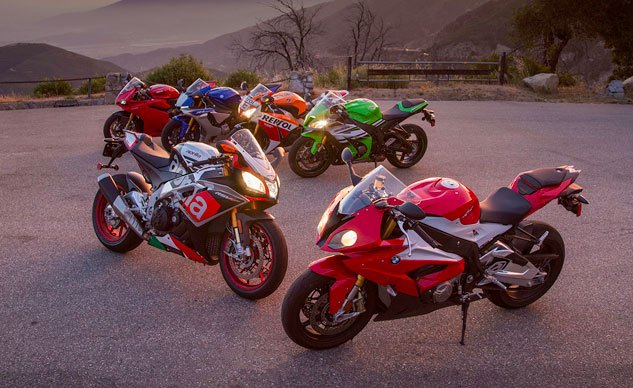
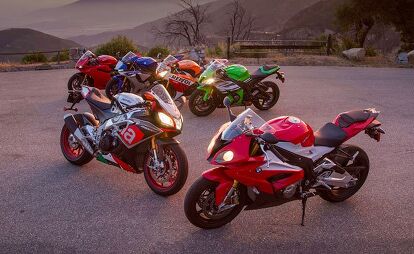










































































































































































































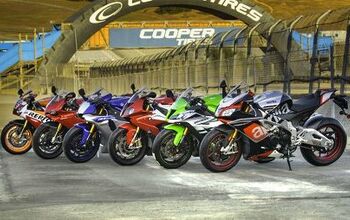
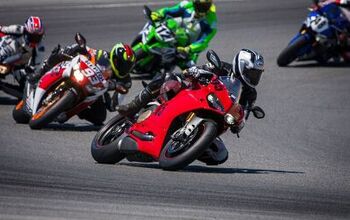
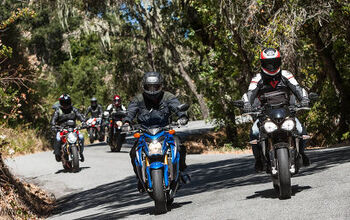
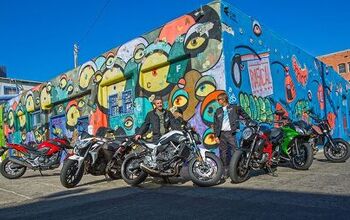
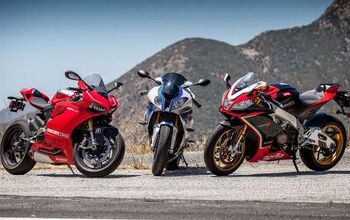










Comments
Join the conversation
Man that Ducati is light! 427 lbs, that's ridiculous for a bike like that. The BMW doesn't do much for me, but I do like that Aprilia.
Yep, great article--a seeming testament to unbiased reporting/journalism. Only nit pick would be that I wish you guys were able to test the less expensive versions of the Duc and Aprilia to make it a more even playing field. I don't doubt that the results would still be similar though...
Looking at the dashboards of the bikes, I'm puzzled why more manufacturers don't go to a set up similar to the Duc and Yam. I'd be willing to shell out a few hundred more $$ for that type of set up...